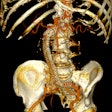Applying virtual reality (VR) and augmented reality (AR) technology to abdominal ultrasound examinations can boost the spatial understanding and procedural skills of trainees, Italian researchers have found.
"This innovative approach not only enhances learning but also contributes to improved patient care by producing well-prepared and confident medical practitioners," stated Dr. Pasquale Maria Parrella and colleagues from Campania University "Luigi Vanvitelli" in Naples. "The integration of VR technology into medical education represents a paradigm shift in how we prepare the healthcare professionals of the future."
 Ultrasound is an operator-dependent technique, the success of which rests on good training. All figures courtesy of Dr. Pasquale Maria Parrella et al and ESR EPOS database.
Ultrasound is an operator-dependent technique, the success of which rests on good training. All figures courtesy of Dr. Pasquale Maria Parrella et al and ESR EPOS database.
With its immersive and dynamic nature, VR can effortlessly transform the learning experience, particularly in the domain of anatomy study using ultrasound, they explained. Previously confined to textbooks and mere observation, the introduction of VR has opened new horizons, offering medical students captivating and interactive learning opportunities.
The Naples researchers have developed a 180-degree VR system specifically designed to enhance the training process for medical students in abdominal ultrasound.
A VR platform, with dynamic and engaging environments created by AR, enables trainees to explore the intricacies of human anatomy and enhance diagnostic skills in performing ultrasound abdominal scanning, they explained. The VR system is primarily based on Dual Fish Eye optics, which are fully compatible with mirrorless cameras utilizing 8K sensors for unparalleled stereoscopic 180° video performances.
"Ultrasound examinations were recorded in different abdominal districts in this unique setting," Parrella and colleagues said. "This innovative approach allowed for more realistic simulations, complete with haptic feedback and interactive 3D interfaces, facilitating greater immersion for students in various medical scenarios."
 VR offers benefits for educators and learners and can deliver repeatable, standardized, and cost-effective clinical training on demand.
VR offers benefits for educators and learners and can deliver repeatable, standardized, and cost-effective clinical training on demand.
Preliminary results from the group's ongoing research clearly indicate that VR with AR scenarios have a profound impact on medical education. "Immersing themselves in ultrasound scenarios, medical students improved their sonographic abilities, learning spatial and anatomical relationships."
The platform also played a key role in facilitating remote learning and collaboration, the authors continued. "Through its advanced connectivity features, it successfully connected both the students and instructors across different geographical boundaries. This breakthrough enabled them to benefit from a more efficient and effective learning experience."
 A well-designed controlled study is necessary to precisely quantify the extent of improvement facilitated by the integration of VR and AR technologies.
A well-designed controlled study is necessary to precisely quantify the extent of improvement facilitated by the integration of VR and AR technologies.
Overall, training is undergoing a transformative shift with the integration of cutting-edge technology, the researchers concluded.
"The protocol feasibility, as well as the preliminary feedback, strongly support the potential use of VR and AR in the context of learning abdominal ultrasound examinations," they said. "Given the promising results observed thus far, it is crucial to conduct a well-designed controlled study that aims to precisely quantify the extent of improvement facilitated by the integration of VR and AR technologies in this specific area of education."
For further details, go to the full ECR 2024 exhibit on the EPOS website of the ESR (epos.myesr.org/poster/esr/ecr2024/C-17505). The co-authors were Drs. A. Fabozzi, M. P. Belfiore, F. Urraro, V. Cantisani, G. Vallone, A. Dell'Era, and F. Grassi.




















